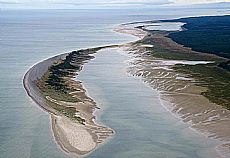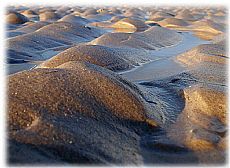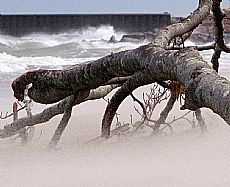Culbin Sands
01 April 2011
- News Type:
- Site of the Month
Currently Culbin’s ever changing shoreline measures approximately 14km and is made up primarily of saltmarsh, sheltered mudflats, stretches of sand speckled with areas of shingle and forest topped dunes. The dunes cover approximately 3100 hectares and can vary in height up to 35m. The sandhills stretch westward from Findhorn to Nairn.
Photograph by Dave Shillabeer
The site in early prehistory would have consisted of light, wind blown soils and as a result was a very fertile location, attracting human settlement. There is evidence of human activity throughout prehistory up to the later 1600’s when the landscape was eventually engulfed in sand.
Culbin has since been visited by many generations of antiquarians and collectors from as early as the late medieval period. A variety of archaeological sites and finds have been discovered at Culbin by these investigators over the years, including shell middens, flint tools and burial evidence from earlier prehistory, evidence of bronze metal working and glass bead manufacture from later prehistory, not to mention many different metal objects such as bronze buckles, pins and needles from the medieval estate through to modern times. The site has been used as a training ground for military maneuvers and for specific training for the D-Day landings during World War Two. Remains of a crashed fighter jet and anti glider landing platforms still exist in the forest and on the shoreline today.
The evidence of shell middens and others sites in the region is mainly recorded through journals and other reports written by the antiquarians and archaeologists who have visited and investigated these sites. Often all evidence of individual structures or find spots has been hidden by the constantly moving sand, leaving the documentary sources written by these interested parties the best source of information. As a result the story of the sites and activity at Culbin Sands is best told through the many objects found in this dune system.
Photograph by Dave Shillabeer
Although there have been many significant finds from prehistory, Culbin Sands is perhaps best known locally for the activity here in the medieval period. A large tract of land around Culbin formed part of the Kinnaird Estate in the 1600s. In the 16th century links with the church were broken, including a withdrawal of its provision of accommodation and support for the people. Landless, poverty stricken serfs had to build their own shacks, using the only material to hand, marram grass. The grass was removed by the soil binding roots as it was easier than cutting it by the stems. Over several generations the sand dunes became increasingly unstable and the sand drifted inland, spoiling fertile land, fields, orchards and gardens. Prior to this the area had been known as the garden and granary of Moray. In 1663 Nairn Town council forbade the cutting of marram grass, broom and seaside turf. This law has never been changed. Alas, too much damage was already done and disaster struck the Kinnaird estate the following year. The entire estate is reputed to have been engulfed in sand over a two day sandstorm, leaving no sign of the estate house and buildings.
Photograph by Dave Shillabeer
The bankrupt Kinnairds were forced to abandon the now worthless estate to the sands. This catastrophic devastation of a prestigious family and their source of income has led to legends of a curse arising and speculation as to what might have brought this down on the Kinnaird family.
For more information on the archaeology of Culbin Sands and a chance to see some of the finds visit Nairn Museum. Opening on the 4th April for it’s 2011 season the temporary exhibit ‘Culbin Sands: Prehistory to Present’ demonstrates the archaeological evidence for activity at this site over the past eight thousand years. The exhibit has been put together by local community and museum volunteer participants in the recent ARCH Display the Past course held at Nairn Museum.
Useful References:
Ross, S. 1992 'Culbin Sands Fact and Fiction.' Copies available in Highland Libraries.
MHG14853 WW2 Armoured Tank
Site of the Month Archive
- 10/04/2021 Easter Raitts township
- 02/03/2021 Lower Slackbuie, Inverness (ASDA) Neolithic site
- 01/02/2021 Balnuaran of Clava cairns
- 04/01/2021 Wilkhouse Inn
- 02/12/2020 Spinningdale Cotton Mill
- 02/11/2020 Skibo A Canadian Forestry Camp
- 01/10/2020 WWI Detonator Store, Dalmore near Invergordon
- 03/09/2020 Mesolithic Shell Midden at Sand, Wester Ross
- 08/08/2020 Kinbeachie Neolithic settlement
- 01/07/2020 Armadale Cist Burial and Stone & Timber Complex



